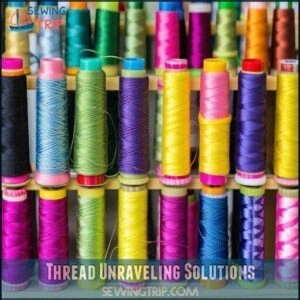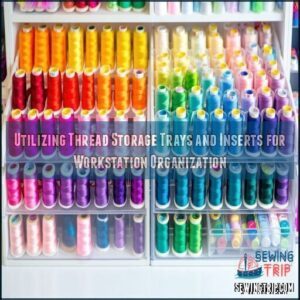This site is supported by our readers. We may earn a commission, at no cost to you, if you purchase through links.
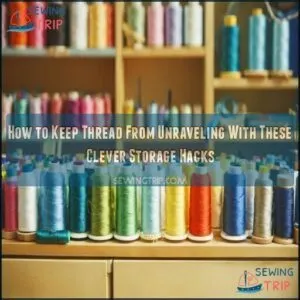 If you’re tired of chasing runaway threads, there are some clever tricks to keep them in check.
If you’re tired of chasing runaway threads, there are some clever tricks to keep them in check.
Many spools have built-in notches—just tuck the thread end into one. No notches? No problem. A small piece of tape, a silicone band, or even a ponytail holder can do the trick.
For a bit more flair, try thread clips or spool caps. If your spools tend to roll around like toddlers on a sugar high, consider using thread nets or silicone wraps.
These simple solutions keep your thread tidy and ready to use, saving you from the frustration of an unraveled mess!
Table Of Contents
Key Takeaways
- Tuck thread ends into the spool’s built-in notches or wrap them under existing thread wraps to keep them secure.
- Use silicone bands, tape, or spool caps to prevent thread from tangling or unraveling.
- Store spools in clear bins, organized trays, or wall-mounted racks to maintain order and visibility.
- Use thread clips, ponytail holders, or thread nets to keep spools tidy and ready to use.
Thread Unraveling Solutions
Ever feel like your spools are conspiring to create tangles? Let’s tackle those thread spool problems with smart, simple tricks!
Tame those rebellious spools and banish tangles with clever tricks that make sewing smooth and stress-free!
Start with Spool Notch Usage—many spools come with built-in notches perfect for securing loose ends.
No notches? No problem! Tape Application or silicone bands work wonders to lock threads in place.
For a smoother option, rely on Thread Clips to keep things tidy.
Another quick thread unraveling solution is Tucking Thread under existing wraps—an effortless fix!
Spool Security can also come from wrapping ponytail holders or using Thread Nets, which snugly hold threads without tangling.
2 Best Thread Storage Organizers
Keeping your thread organized doesn’t have to be a hassle when you’ve got the right tools.
Let’s explore two simple yet brilliant storage solutions that prevent tangles and make your sewing space more efficient.
These solutions will help improve your overall sewing experience.
1. Ikea Helmer Drawer Unit White
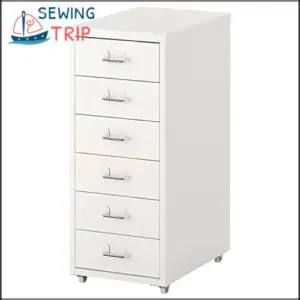
When battling thread spool problems, the IKEA Helmer is your ally for order.
This compact, rolling unit transforms thread chaos into harmony with smart design and customization options. It’s built for durability, with six smooth-glide drawers that welcome thread storage solutions of all kinds.
Here’s why the Helmer rocks:
- Helmer Customization: Use drawer dividers for space optimization and better thread management.
- Thread Unraveling Control: Keeps spools safe from tangling.
- Unit Assembly: Easy to set up and sturdy for daily use.
- Color Coordination: Label slots make identifying threads by shade simple.
- Portability: Casters let you roll creativity across your craft space.
Consider categorizing threads by color for easier selection. Keep things tidy, and sewing feels effortless!
2. Isacord Thread Storage Trays
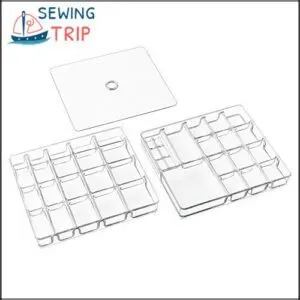
Isacord trays are like VIP suites for your threads, keeping everything neat and tangle-free.
Unlike bulky storage boxes, these trays boast a Dual Grip Design to keep spools steady—no slipping or sliding during projects! Each tray holds 36 spools and fits snugly in an ArtBin Super Satchel, making them a dream for organizing and travel.
Their Stackable Design saves space, perfect for tight sewing corners. Add Color-Coded Inserts to sort threads by shades for easy access.
The trays also feature thread retention grips, preventing that frustrating unraveled mess. Need extra flexibility? Use trays with Adjustable Compartments for various spool sizes.
With Isacord’s spool thread control and tangle-prevention, you’ll spend less time chasing loose ends and more time sewing beautifully!
Thread Storage and Organization on The Wall
Keeping your thread neatly stored on the wall doesn’t just save space—it also prevents those frustrating tangles.
With a few hooks, racks, or clever wall-mounted organizers, you’ll have everything at your fingertips and looking as tidy as a craft store display, which is a key aspect of maintaining a well-organized workspace, emphasizing the importance of being tidy.
Using Wall-mounted Thread Storage Units for Space-saving Organization
Putting your wall space to work can revolutionize your thread organization. Vertical storage saves room and keeps your thread spools neat, protected, and easy to grab. Wall-mounted storage isn’t just practical—it’s like art that makes sewing simpler.
Wall storage transforms chaos into creativity, combining practicality with elegance to keep your sewing space neat, tidy, and inspiring.
Follow these tips to maximize your wall-mounted thread storage:
- Use clear acrylic racks to hold spools at eye level, letting you match colors without digging around.
- Organize by color on sturdy dowel rods. It’s a functional, rainbow look that’ll brighten your room and your mood.
- Install pegboard sections around racks for bonus storage. Hang smaller spools, tools, or bobbin holders to keep everything tidy.
For a sturdier setup, consider using metal thread racks. With wall-mounted storage, you’ll skip the tangled mess and focus on creating. It’s space-saving, organized, and oh-so satisfying!
Installing Hooks for Hanging Thread Spools and Reels
Make the most of your wall space with smart hook placement to transform your sewing area into a thread organization haven.
Use hooks designed for various spool sizes and weights—just make sure they’re sturdy enough to hold your thread spools securely. For flexibility, try pegboards or adjustable thread hooks.
Mount your setup 48-67 inches high for easy, ladder-free access. You can even find specialized thread spool options to maximize your storage.
This approach blends accessibility design with practicality, keeping everything neat and tangle-free. Bonus: Color-code your spools by project or shade.
With clever thread storage, you’ll keep thread unraveling at bay while creating a visually stunning and organized workspace.
Thread Storage in a Drawer or Workstation
Keeping thread neat in a drawer or workstation doesn’t have to be a headache.
With trays, dividers, and a little effort, you can keep everything untangled, easy to find, and ready to go.
Utilizing Thread Storage Trays and Inserts for Workstation Organization
Give your threads the royal treatment by incorporating clever thread storage trays and inserts into your workspace. These thread storage solutions help boost workspace efficiency and stop thread unraveling before it even begins!
Here are five smart ways you can organize your workstation:
- Choose trays made from sturdy tray materials that can hold up to daily use.
- Look for inserts with customizable compartments to fit spools of all sizes.
- Add color coordination inserts to quickly find the thread you need.
- Use double-sided organizers to double your spool capacity without needing extra space.
- Try removable sections for easy access during projects.
Consider exploring options for dedicated thread organizers to maximize space. By embracing proper thread tray organization, you’ll keep your thread spool storage neat, tidy, and ready to shine!
Creating a Thread Storage System Using Dividers and Compartments
Organizing threads in drawers doesn’t have to feel like herding cats.
With Adjustable Dividers and Custom Inserts, you’ll create seamless thread compartments that keep everything neat and untangled.
Optimize your space with these practical ideas:
- Drawer dividers: Sort threads by color, size, or brand for quick access.
- Clear bins with compartments: Protect threads from dust while keeping them visible.
- Wine dividers: A chic, unexpected way to group spools.
For maintaining thread order, consider using drawer dividers effectively.
Using these thread storage solutions stops thread unraveling and restores order to your sewing haven.
Frequently Asked Questions (FAQs)
How do you keep a spool from unraveling?
Ever feel like spools have minds of their own?
Tuck thread ends into spool notches, secure them with silicone bands, or wrap with tape.
It’s a quick way to stop tangles and keep things tidy!
How do you keep thread from unraveling from a spool?
Secure thread by tucking the end into spool notches or wrapping it around the spool’s core, then cover with a silicone band or tape.
Spool caps or thread clips also work wonders for taming unruly threads!
How do I Keep my spools safe?
Keep your spools safe by storing them in clear bins or thread trays with compartments.
Use spool caps or silicone bands to prevent unraveling.
A cool, dry spot helps avoid stress-spots and keeps them lasting longer, which is a key factor in making them last longer.
How to prevent thread unraveling?
Tame those rebellious thread ends by using spool caps, silicone bands, or notches on your spools.
A quick wrap with tape or a ponytail holder also works wonders.
It’s simple—no more thread chaos!
How do you hold a thread in a spool?
Imagine this scenario: your thread’s a runaway train.
To stop it, find the spool’s notch, tuck the thread inside, and secure it.
If there’s no notch, use tape, rubber bands, or those tiny spool caps.
How do you keep thread from tangling?
Tuck thread ends tightly under the spool’s wraps or use spool caps, silicone bands, or thread huggers for extra security.
A dab of tape works too.
Tangled thread’s like a bad hair day—easily preventable!
What is a thread spool saver?
A thread spool saver is like a tiny superhero, wrapping around your spool to stop thread from unraveling.
It’s usually a silicone band or clip that keeps everything snug, preventing tangles and saving time.
How to stop thread from unraveling from spool?
Secure loose thread ends by wrapping them around the spool’s core, tucking them under existing wraps, or using spool caps, tape, or silicone bands.
These simple tricks prevent tangles and keep everything neat—no stress!
How to secure thread on spool?
When thread misbehaves like an unruly guest, fix the end into spool notches or wrap it snugly with a silicone band.
You can even corral it with tape or repurpose a ponytail holder.
Easy-peasy!
How do you store a thread so it doesn’t unravel?
Store thread securely by wrapping loose ends under existing wraps or using spool caps, silicone bands, or thread clips.
Keep spools in dry, organized spaces like clear bins, trays, or racks to avoid tangles.
Conclusion
Keeping thread from unraveling can be as simple as taming wild hair—just use the right tools.
From built-in spool notches to creative hacks like tape or ponytail holders, there’s a solution for every crafter.
Explore wall-mounted units or drawer organizers for tidy storage that saves space and sanity.
Don’t let rolling spools or tangled threads slow you down.
With these clever storage hacks, you’ll have neat, organized spools ready to use whenever inspiration strikes!

